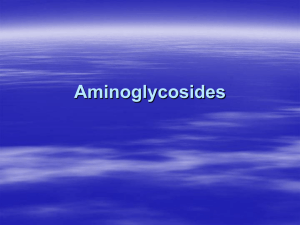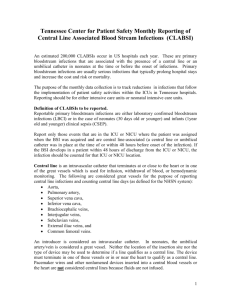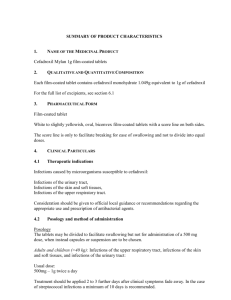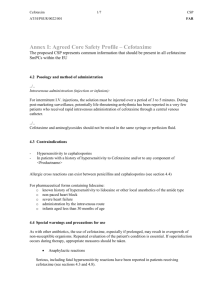SINTEZ New Production Implementation Department P N001561/01
advertisement
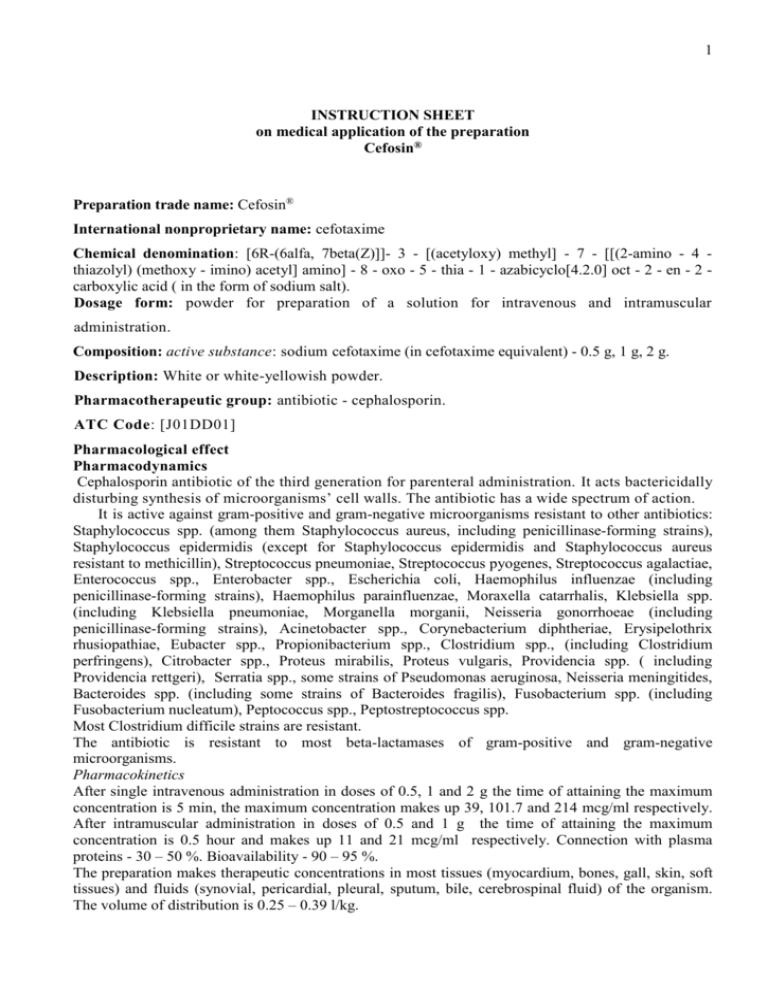
1 INSTRUCTION SHEET on medical application of the preparation Cefosin® Preparation trade name: Cefosin® International nonproprietary name: cefotaxime Chemical denomination: [6R-(6alfa, 7beta(Z)]]- 3 - [(acetyloxy) methyl] - 7 - [[(2-amino - 4 thiazolyl) (methoxy - imino) acetyl] amino] - 8 - oxo - 5 - thia - 1 - azabicyclo[4.2.0] oct - 2 - en - 2 carboxylic acid ( in the form of sodium salt). Dosage form: powder for preparation of a solution for intravenous and intramuscular administration. Composition: active substance: sodium cefotaxime (in cefotaxime equivalent) - 0.5 g, 1 g, 2 g. Description: White or white-yellowish powder. Pharmacotherapeutic group: antibiotic - cephalosporin. ATC Code: [J01DD01] Pharmacological effect Pharmacodynamics Cephalosporin antibiotic of the third generation for parenteral administration. It acts bactericidally disturbing synthesis of microorganisms’ cell walls. The antibiotic has a wide spectrum of action. It is active against gram-positive and gram-negative microorganisms resistant to other antibiotics: Staphylococcus spp. (among them Staphylococcus aureus, including penicillinase-forming strains), Staphylococcus epidermidis (except for Staphylococcus epidermidis and Staphylococcus aureus resistant to methicillin), Streptococcus pneumoniae, Streptococcus pyogenes, Streptococcus agalactiae, Enterococcus spp., Enterobacter spp., Escherichia coli, Haemophilus influenzae (including penicillinase-forming strains), Haemophilus parainfluenzae, Moraxella catarrhalis, Klebsiella spp. (including Klebsiella pneumoniae, Morganella morganii, Neisseria gonorrhoeae (including penicillinase-forming strains), Acinetobacter spp., Corynebacterium diphtheriae, Erysipelothrix rhusiopathiae, Eubacter spp., Propionibacterium spp., Clostridium spp., (including Clostridium perfringens), Citrobacter spp., Proteus mirabilis, Proteus vulgaris, Providencia spp. ( including Providencia rettgeri), Serratia spp., some strains of Pseudomonas aeruginosa, Neisseria meningitides, Bacteroides spp. (including some strains of Bacteroides fragilis), Fusobacterium spp. (including Fusobacterium nucleatum), Peptococcus spp., Peptostreptococcus spp. Most Clostridium difficile strains are resistant. The antibiotic is resistant to most beta-lactamases of gram-positive and gram-negative microorganisms. Pharmacokinetics After single intravenous administration in doses of 0.5, 1 and 2 g the time of attaining the maximum concentration is 5 min, the maximum concentration makes up 39, 101.7 and 214 mcg/ml respectively. After intramuscular administration in doses of 0.5 and 1 g the time of attaining the maximum concentration is 0.5 hour and makes up 11 and 21 mcg/ml respectively. Connection with plasma proteins - 30 – 50 %. Bioavailability - 90 – 95 %. The preparation makes therapeutic concentrations in most tissues (myocardium, bones, gall, skin, soft tissues) and fluids (synovial, pericardial, pleural, sputum, bile, cerebrospinal fluid) of the organism. The volume of distribution is 0.25 – 0.39 l/kg. 2 The half-life period is 1 hour in case of intravenous administration and 1-1.5 hour if the preparation is administered intramuscularly. It is eliminated by kidneys: 20-36 % in an unchanged form, the rest - in the form of metabolites (15-25 % - in the form of pharmacologically active desacetylcefotaxime and 20-25 % in the form of 2 non-active metabolites - M2 and M3). In patients with chronic kidney failure and elderly people the half life period increases twice as much. In newborns, the half-life period is 0.75-1.5 hour, in premature newborns (the body weight less than 1500 g) the half-life period increases up to 4.6 hours, in children with a body weight of more than 1500 g - 3.4 hours. During repeated intravenous administrations in a dose of 1g every 6 hours within 14 days the accumulation is not observed. Cefotaxime passes through placenta and gets into breast milk. Indications for application Infectious and inflammatory diseases caused by sensitive microorganisms: - infections of the central nervous system (meningitis) - infections of respiratory ways, ears, nose and throat - infections of urinary tracts - infections of bones and joints - infections of skin and soft tissues - infections of organs of small pelvis - gonorrhea - infected wounds and burns - peritonitis - sepsis - abdominal infections - endocarditis - Lyme desease - salmonellosis - infections against the background of immunodeficiency. Prophylaxis of infections after surgeries (including urologic and obstetric/gynecologic surgeries, gastrointestinal tract surgeries). Counter-indications Hypersensitiveness (including hypersensitiveness to penicillins, other cephalosporins, carbapenems), pregnancy, children’s age - up to 2.5 years old (intramuscular administration). With care Neonatal period, chronic kidney failure, nonspecific ulcerative colitis (including in the medical history). Administration during pregnancy and in the lactation period Administration during pregnancy is counter-indicated. If it is necessary to administer the drug in the lactation period, breast-feeding should be terminated. Method of application and dosage The preparation is administered intravenously (stream or drop-by-drop introduction) or intramuscularly. In adults and children with a body weight of 50 kg and more: in case of noncomplicated infections and infections of urinary tracts – 1 g every 8-12 hours intramuscularly or intravenously; in patients with noncomplicated acute gonorrhea - 1g single dose intramuscularly; in patients with infections of moderate severity - 1-2 g every 12 hours intramuscularly or intravenously; in case of very severe infections (meningitis, for example) – 2 g every 4-8 hours intravenously, the maximum daily dose should be 12g. Duration of treatment should be determined individually. For the purpose of infection prophylaxis, before a surgery 1g of the preparation is administered singly during initial general anesthesia. If necessary, the administration should be repeated in 6-12 hours. 3 In case of a caesarean section during clipping of umbilical veins - 1g intravenously, then - 1g additionally in 6 and 12 hours after the first dose. In patients with creatine clearance of 20 ml/min/1.73 m2 and less the daily dose should be reduced twice. In premature newborns and newborns at the age of less than 1 week – 50 mg/kg intravenously every 12 hours; at the age of 1-4 weeks – 50 mg/kg intravenously every 8 hours; in children with a body weight of up to 50 kg - 50-180 mg/kg in 4-6 intravenous or intramuscular administrations (children older than 2.5 years old). In case of severe infections (including meningitis) the daily dose of children should be increased up to 100-200 mg/kg (intramuscular or intravenous administration), 4-6 introductions, the maximum daily dose is 12g. Preparation of injection solutions: for intravenous injections, water for injections is used as a solvent (0.5-1g is diluted in 4ml of the solvent, 2 g - in 10 ml); for intravenous infusions - 0.9 % solution of sodium chloride or 5 % solution of dextrose (1-2 g is diluted in 50-100 ml of a solvent) are used as a solvent. Infusion duration is 50-60 min. For intramuscular administration, water for injections or 1 % solution of lidocaine are used (for a drug dose of 0.5g – 2 ml, for a dose of 1g - 4 ml). Side effects Allergic reactions: generalized rash, shivering or fever, eruption, itch, rarely - bronchismus, eosinophilia, Stevens-Johnson syndrome, toxic epidermal necrolysis (Lyell's syndrome), acute essential edema, rarely - anaphylactic shock. Nervous system: headache, dizziness. Excretory tract: kidney malfunction, oliguria, interstitial nephritis. Intestinal system: nausea, vomiting, diarrhea or constipation, meteorism, abdominal pains, dysbacteriosis, compromised liver function, rarely - stomatitis, glossitis, pseudomembranous enterocolitis. Blood-forming organs: hemolytic anemia, leucopenia, neutropenia, granulocytopenia, thrombocytopenia, incoagulability. Cardiovascular system: potentially life-threatening cardiac arrhythmia after quick bolus injection into the central vein. Local reactions: phlebitis, painfulness along the vein, painfulness and infiltrate at the site of intramuscular introduction. Laboratory parameters: azotemia, increase of blood urea concentration, increase of activity of hepatic transaminases and alkaline phosphatase, hypercreatinemia, hyperbilirubinemia, positive Coombs' test. Other side effects: superinfection (including candidiasis vaginitis). Overdosage Symptoms: convulsions, encephalopathy (during administration of large doses, especially in patients with kidney failure), tremor, neuromuscular irritability. Treatment: symptomatic therapy, no specific antidotes. Interaction with other medicinal agents Simultaneous administration with anticoagulants, non-steroidal anti-inflammatory drugs increases risk of bleedings. Probability of kidney affection increases during simultaneous administration with amino glycosides, polymyxin B and loop diuretics. Medicinal agents blocking tubular secretion increase plasma concentrations of cefotaxime and slow down its elimination. The preparation is pharmaceutically incompatible with solutions of other antibiotics in a syringe or a drop bottle. 4 Special instructions Pseudomembranous (long-term severe diarrhea) colitis may occur in the first weeks of treatment. In this case, the use of the drug should be discontinued, and the proper therapy should be prescribed (including vancomycin and metronidazole). Patients with allergic penicillin reactions in the medical history may have hypersensitivity to cephalosporin antibiotics. When treating with the drug for more than 10 days, it is necessary to control the number of blood corpuscles. During treatment with cefotaxime a false-positive Coombs reaction and a false-positive glucose urine test are possible. During simultaneous administration of cefotaxime and ethanol disulfiram-like reactions (hyperemia of face, spasm in abdomen and in the stomach area, nausea, vomiting, headache, decrease of blood pressure, tachycardia, shortbreathing) may develop. Form of manufacturing Powder for preparation of a solution for intravenous and intramuscular administration - 0.5 g, 1 g, 2 g in 10 ml or 20 ml vials made of colorless or dark glass. 1, 5, 10 vials with an instruction sheet are placed into a cardboard box. 50 vials are put in a cardboard box with 5 instruction sheets for delivery to in-patient clinics. 1 vial with the preparation, 1 ampule with a solvent (10 ml of sodium chloride solution for injections 0.9 %) are placed into a blister pack. 1 blister pack with an ampule scarificator and instruction sheet are put in a cardboard box. 5 vials with the drug are placed into a blister pack. 1 blister pack with the drug, 1 blister pack with 5 ampules with a solvent (10 ml of sodium chloride solution for injections - 0.9 %), scarificator, instruction sheet are placed in a cardboard box. When using ampules with break rings or opening notches and break points, scarificators are not enclosed. Storage conditions List B. Store in a dry dark place at a temperature of not more than 25ºC. Keep out of reach of children. Period of validity 3 years. Do not use after expiration date. Conditions of supply from chemist's shops: On doctor’s prescription. Customer complaints are accepted by the manufacturer: Open Joint Stock "Kurgan Joint Stock Company of Medical Preparations and Articles "Sintez" (JSC Sintez) 640008 Russia, City of Kurgan, 7 Prospect Constitutsiyi. Tel/fax: (3522) 48-16-89 Internet site: http://www.kurgansintez.ru

